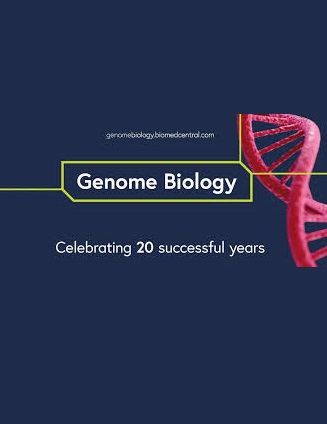A benchmark of computational methods for correcting biases of established and unknown origin in CRISPR-Cas9 screening data
IF 10.1
1区 生物学
Q1 BIOTECHNOLOGY & APPLIED MICROBIOLOGY
引用次数: 0
Abstract
CRISPR-Cas9 dropout screens are formidable tools for investigating biology with unprecedented precision and scale. However, biases in data lead to potential confounding effects on interpretation and compromise overall quality. The activity of Cas9 is influenced by structural features of the target site, including copy number amplifications (CN bias). More worryingly, proximal targeted loci tend to generate similar gene-independent responses to CRISPR-Cas9 targeting (proximity bias), possibly due to Cas9-induced whole chromosome-arm truncations or other genomic structural features and different chromatin accessibility levels. We benchmarked eight computational methods, rigorously evaluating their ability to reduce both CN and proximity bias in the two largest publicly available cell-line-based CRISPR-Cas9 screens to date. We also evaluated the capability of each method to preserve data quality and heterogeneity by assessing the extent to which the processed data allows accurate detection of true positive essential genes, established oncogenetic addictions, and known/novel biomarkers of cancer dependency. Our analysis sheds light on the ability of each method to correct biases under different scenarios. AC-Chronos outperforms other methods in correcting both CN and proximity biases when jointly processing multiple screens of models with available CN information, whereas CRISPRcleanR is the top performing method for individual screens or when CN information is not available. In addition, Chronos and AC-Chronos yield a final dataset better able to recapitulate known sets of essential and non-essential genes. Overall, our investigation provides guidance for the selection of the most appropriate bias-correction method, based on its strengths, weaknesses and experimental settings.校正 CRISPR-Cas9 筛选数据中已确定和未知来源偏差的计算方法基准
CRISPR-Cas9 剔除筛选是以前所未有的精度和规模研究生物学的强大工具。然而,数据中的偏差会对解释产生潜在的混淆效应,并影响整体质量。Cas9 的活性受靶位点结构特征的影响,包括拷贝数扩增(CN 偏倚)。更令人担忧的是,近端靶位点往往会对CRISPR-Cas9靶向产生类似的基因无关反应(近端偏倚),这可能是由于Cas9诱导的全染色体臂截断或其他基因组结构特征以及不同的染色质可及性水平造成的。我们对八种计算方法进行了基准测试,严格评估了它们在迄今为止两个最大的基于细胞系的公开 CRISPR-Cas9 筛选中减少 CN 偏差和邻近偏差的能力。我们还通过评估处理后的数据能在多大程度上准确检测出真正的阳性重要基因、已确定的肿瘤基因成瘾以及已知/新的癌症依赖性生物标志物,从而评估了每种方法在保持数据质量和异质性方面的能力。我们的分析揭示了每种方法在不同情况下纠正偏差的能力。当联合处理具有可用 CN 信息的多个模型筛选时,AC-Chronos 在纠正 CN 和邻近性偏差方面优于其他方法,而 CRISPRcleanR 则是单个筛选或没有 CN 信息时表现最好的方法。此外,Chronos 和 AC-Chronos 产生的最终数据集能更好地再现已知的基本和非基本基因集。总之,我们的研究为根据偏差校正方法的优缺点和实验设置选择最合适的偏差校正方法提供了指导。
本文章由计算机程序翻译,如有差异,请以英文原文为准。
求助全文
约1分钟内获得全文
求助全文
来源期刊

Genome Biology
Biochemistry, Genetics and Molecular Biology-Genetics
CiteScore
21.00
自引率
3.30%
发文量
241
审稿时长
2 months
期刊介绍:
Genome Biology stands as a premier platform for exceptional research across all domains of biology and biomedicine, explored through a genomic and post-genomic lens.
With an impressive impact factor of 12.3 (2022),* the journal secures its position as the 3rd-ranked research journal in the Genetics and Heredity category and the 2nd-ranked research journal in the Biotechnology and Applied Microbiology category by Thomson Reuters. Notably, Genome Biology holds the distinction of being the highest-ranked open-access journal in this category.
Our dedicated team of highly trained in-house Editors collaborates closely with our esteemed Editorial Board of international experts, ensuring the journal remains on the forefront of scientific advances and community standards. Regular engagement with researchers at conferences and institute visits underscores our commitment to staying abreast of the latest developments in the field.
文献相关原料
| 公司名称 | 产品信息 | 采购帮参考价格 |
|---|
 求助内容:
求助内容: 应助结果提醒方式:
应助结果提醒方式:


